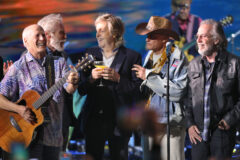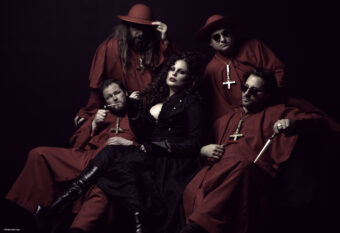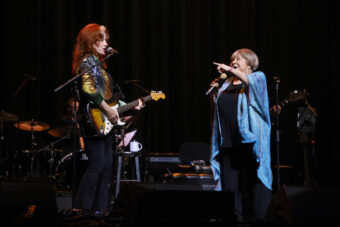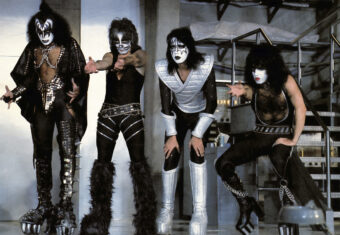Fat Boys
Fat Boys (8)
Traffic Entertainment
Yes, they were sort of a novelty act, but at the root of novelty is a desire to entertain, which takes as much skill and integrity as supposedly higher-minded goals. Though they were undoubtedly rappers, their forefathers weren’t in rap but in black doo-wop and early rock groups like the Coasters — acts unafraid to put themselves at the butt of a joke, acts unafraid to make fart noises with their mouths. When they rob a pizza place, it’s not for the money, but because they’re hungry for pizza. “Don’t You Dog Me” features several samples of actual dogs. But they have rhythm, too, and heart. The tough con of another rapper’s narrative turns into a lonely boy waiting for a letter, and when they peacock for the ladies, it’s with the caveat that just because they’re fat doesn’t mean they’re unbreakable. Humbly, they want to rock the house.
English Beat
The Complete Beat (8)
Keep the Beat: The Very Best of the English Beat (9)
Shout! Factory
Few genres of music are more maligned than ska. Just say it aloud to yourself: ska. Skank. Skanking. It conjures checkered scarves and pinstripe suits and complicated pocket watches. Ska in 2012 is kind of like Colonial Williamsburg, a single-word joke about a style so limited that it was bound to become a bug trapped in amber. But there was a time that it was some of the smartest and socially incisive music around, especially in England, where it had been imported by West Indian dockworkers and developed by working-class people both black and white. And like the best socially incisive music, it understood that you’re more likely to get a movement going if it involves dancing, which has long been a more effective way to gather people together than protest.
Of all the great ska bands, the English Beat were the most refined — by their second album, they were already moving on to ’80s multi-culti fantasies of French-language Afrobeat and New Wave. As performers, they had the rare gift of being able to make narrow, tightly wound music sound effortless. This is a trick they borrowed from reggae, a genre whose success depends on being able to relax as precisely as possible.
Two ways to go here, basically: One is a modestly priced box set with remastered versions of everything the band ever recorded; the other is a single-disc best-of. The box features Peel Sessions and dub versions, and it’s nice hearing the original albums in their entirety. The best-of is more or less flawless. In the end, two great skaptions.
Various Artists
Country Funk 1969-1975 (7)
Light in the Attic
The title suggests rare and strange mutations where black and white meld, but if you’ve spent real time in the South, you’ll know that integration is more fluid than Northerners imagine it is, and mixing country with funk isn’t so much a race thing as a class one: Both are music by the people, for the people, and of the people.
As a compilation, Country Funk is an almost textbook example of what boutique labels can do in 2012: Employ a group of passionate nerds to retrospectively invent genres out of deep cuts that may have never been this close together before. In that sense, it’s a thesis in collecting, listening, and associating. It’s also a good demonstration of country and funk’s curious tendencies toward earnest social critique on one hand and straight-up novelty on the other. Where Dennis the Fox’s “Piledriver” falls on the spectrum, I’m happily not sure.
Sleep
Dopesmoker (7)
Southern Lord
Dopesmoker is the archetypal stoner-metal album, which is to say plenty of bands have done the slow-and-sludgy thing well since, but the original artifact endures precisely for its originality. Not to say it isn’t still good — it is, really, and as basically one track running an hour long, it’s also a feat of incredible restraint on the part of the band, who are as brutal and dim in the first minute as in the 50th, never losing hold of a groove that halfway through starts to sound prehistoric, as though nothing existed before it and nothing has truly existed since. Many may liken this feeling of a slow and terminal present to being stoned — hence the title. It’s metal, yes, but the prolonged nature of it suggests an easy comparison to the pattern- and drone-heavy approach of 1970s composition, which is what spawned all those condescending thinkpieces asserting that metal was finally art. Die-hards will argue over which of the many versions of the album is best; none will agree. For now, this is what’s in print.
Paul McCartney
Ram (5)
Hear Music
In retrospect, McCartney’s second album was a precursor for all kinds of eccentric, channel-changing indie-rock; and like a lot of eccentric, channel-changing indie-rock, it approaches its humor with an upturned nose and a slightly clenched asshole. In a way, the indulgences are expected: John Lennon was enjoying his freedom from the Beatles too, and without each other, both men started sinking into their own private deep ends. Not even on side two of Abbey Road would Paul have gotten away with a mini-suite as flatly committed to goofy voices as “Uncle Albert/Admiral Halsey.” There are some amazing tracks, “Smile Away” and “Monkberry Moon Delight,” in particular. The rest is like baking a cake just to eat the frosting.
Annette Peacock
I’m The One (8)
Future Days/Light In the Attic
Because the world needs more radically unconventional soul-jazz singers who howl and shriek in the face of anything resembling song. Or, as one of Peacock’s own titles goes, “Gesture Without Plot.” Her grace is that she knows how to make all her experiments sound playful and intensely erotic — basically, to remember that there’s a body attached to the brain and that one’s no good without the other. She wails about how she loves her pony. She makes nasty, nasty sounds on her Moog. She sounds joyfully trapped in a world of her own design. Only the truly far-out could possibly relax to music like this. The rest of us can take its challenges as the promise of new horizons, and be grateful that they come with a little funk.
Van Dyke Parks
Song Cycle (7)
Discover America (8)
Clang of the Yankee Reaper (6)
Bella Union
Parks is a writer and arranger best known for helping turn the Beach Boys into an incomparably weird avant-garde band for about a year in the late 1960s. At the height of the Woodstock era, he released Song Cycle, an album of flamboyant, overdressed orchestral pop that took most of its cues from old Hollywood soundtracks. It’s eclectic and brilliant and arty and punny and all that. It’s also sincerely irritating — one of those overburdened first statements that serves less as a demonstration of Parks’s true talents than as a long parade of his ambitions. Critics loved it, audiences less so: At one point, Warner Bros. resorted to taking out an ad shrugging that they had “lost $34,509.50 on ‘the Album of the Year (Dammit).'”
By 1972’s Discover America, he had moved on to Calypso and Caribbean music, with a little New Orleans funk mixed in. Imagine a choirboy doing MENSA puzzles on the deck of a Carnival Cruise ship — now give him a steel drum and some weed. The incongruity of the album is at least half its beauty; the rest is just how easily Parks’ sense of humor melds with the drowsy, colorful sounds of the music. His third album, Clang of the Yankee Reaper, is like Discover America, only a little more rock-oriented, and with weaker songs and less of a unifying theme — more necklace than neck.
Drexciya
Journey of the Deep Sea Dweller II (7)
Clone
Late 2011’s best retrospective of forbidding, hard-ass early-’90s Detroit techno finally gets a sequel — and just in time for summer! Drexciya’s music is defined primarily by two things: dense, grinding drum machines and non-melodic laser-beam sounds. The rest is gravy (i.e. acid). Taken in the context of modern dance music — or ’90s dance music, for that matter — their stuff is basically like a branch lying somewhere underneath the family tree that doesn’t appear to have been broken at either end: One naturally wonders how it got there. Never mind, it’s there (finally).
Avengers
Avengers (6)
Water
What’s notable about this Bay Area band isn’t so much what they did, but when they did it. On some songs, they prefigure hardcore; on others, new wave — by 1977 standards, forward-thinking stuff. The sound is simple and familiar, and will be inadvertently comforting to aging listeners weaned on punk basics — never mind the fact that the same listeners might ignore a band that made music like this in 2012. This is how the cruel march of time works: One year’s innovations become the next year’s traditions. In the absence of stylistic novelty are the songs, some of which are great, particularly “We Are the One,” “I Believe in Me,” and “Thin White Line.” Singer Penelope Houston sacrifices political complexity for directness; the band’s eclecticism seems like a happy byproduct of bashing through their parts without thinking too much about them.





